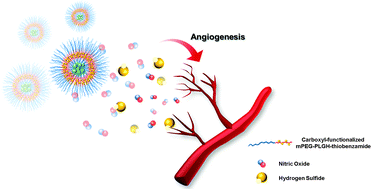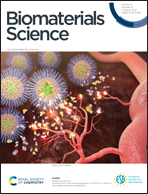Enhanced NO-induced angiogenesis via NO/H2S co-delivery from self-assembled nanoparticles†
Abstract
Nitric oxide (NO) and hydrogen sulfide (H2S) have been the focus of research as therapeutic agents because of their biological functions. The controlled release of NO and H2S can enhance NO-induced angiogenesis by H2S inhibiting PDE5A. Polymeric carriers have been researched to deliver gasotransmitters and used as therapeutic agents because of their important ability to help control the concentration of NO and H2S. Here, NO/H2S-releasing nanoparticles were self-assembled from carboxyl-functionalized mPEG-PLGH-thiobenzamide [(methoxy poly (ethylene glycol-b-lactic-co-glycolic-co-hydroxymethyl propionic acid)-thiobenzamide)], PTA copolymer and encapsulated diethylenetriamine NONOate (DETA NONOate). The PTA copolymers were characterized by FT-IR and 1H NMR, and the PTA-NO nanoparticles (PTA-NO-NPs) were confirmed to have core–shell structures with a size of about 140 nm. The PTA-NO-NPs were demonstrated to be biocompatible with viabilities above 100% in various cell types, with a sustained NO and H2S releasing behavior over 72 h. Co-releasing NO and H2S accelerated tube formation by HUVECs compared to the only NO- or H2S-releasing groups in vitro. Also, PTA-NO-NPs performed enhanced angiogenesis compared to the control groups with statistically significant differences ex vivo. These results indicate the feasibility of medical applications through NO and H2S crosstalk.



 Please wait while we load your content...
Please wait while we load your content...